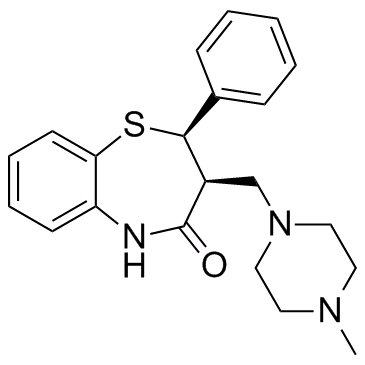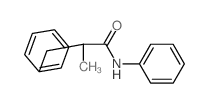BTM-1086
Modify Date: 2025-08-25 22:06:15

BTM-1086 structure
|
Common Name | BTM-1086 | ||
|---|---|---|---|---|
| CAS Number | 72293-17-5 | Molecular Weight | 367.50800 | |
| Density | N/A | Boiling Point | N/A | |
| Molecular Formula | C21H25N3OS | Melting Point | N/A | |
| MSDS | N/A | Flash Point | N/A | |
Use of BTM-1086BTM-1086 is a potent anti-ulcer and gastric secretory inhibiting agent. |
| Name | cis-(+)-2,3-dihydro-3-[(4-methylpiperazinyl)methyl]-2-phenyl-1,5-benzothiazepin-4(5H)-one |
|---|---|
| Synonym | More Synonyms |
| Description | BTM-1086 is a potent anti-ulcer and gastric secretory inhibiting agent. |
|---|---|
| Related Catalog | |
| Target |
Muscarinic receptor[1] |
| In Vitro | Functional and binding experiments shows that the (-) enantiomer (BTM-1086) has a high affinity (pKi=8.31-9.15) for the three muscarinic receptor subtypes in guinea-pig cortex (M1), heart (M2) and salivary glands (M3)[1]. |
| In Vivo | BTM-1086 prevents the development of ulcer at a dose of 0.1 to 1 mg/kg, p.o., but only weakly inhibits the histamine induced gastric ulcer. The inhibitory activities of BTM-1086 are significantly higher than those of atropine sulfate. In the healing experiment with the acetic acid-induced stomach ulcer, BTM-1086 (1 mg/kg/day , p.o., x14) shows a significant healing effect, which is higher than that of propantheline bromide . BTM-1086 at a dose of 0.2 mg/kg , i.d., remarkably inhibits the gastric secretion 6 hr after pylorus ligation. The aspirin-induced reductions of the total acid and K+ as well as the increments of the volume and Na+ in the gastric secretion are prevented dose-dependently by pretreatment with BTM-1086. The LD50 value by oral, s.c., and i.v. administration with this compound is 880, 630 and 113 mg/kg, respectively, for male rats and 830, 650 and 119 mg/kg, respectively, for female rats[2]. |
| Animal Admin | Rats[2] Rats weighing 180 to 190 g are anesthesized with ether and subjected to laparotomy to expose the stomach after which 20 gal of 20% acetic acid is injected carefully under the serous membrane of the abdominal side in the glandular stomach; then the abdomen is closed. Thereafter, the animals are fed normally and 5 mL/kg of BTM-1086 dissolved or suspended in 0.5% gum arabic solution is administered p.o. once daily for 14 days from the second day after the operation. The longitudinal and abscissal length of the areas are quickly measured with a calliper, and the multiplied product is used as the ulcer index[2]. |
| References |
| Molecular Formula | C21H25N3OS |
|---|---|
| Molecular Weight | 367.50800 |
| Exact Mass | 367.17200 |
| PSA | 60.88000 |
| LogP | 3.34950 |
| InChIKey | YGOYABDTPZVXLE-XLIONFOSSA-N |
| SMILES | CN1CCN(CC2C(=O)Nc3ccccc3SC2c2ccccc2)CC1 |
| Precursor 0 | |
|---|---|
| DownStream 2 | |
| cis-2,3-dihydro-3-[(4-methylpiperazinyl)methyl]-2-phenyl-1,5-benzothiazepin-4(5H)-one |
| (+/-)-cis-2,3-dihydro-3-[(4-methylpiperazinyl)methyl]-2-phenyl-1,5-benzothiazepin-4(5H)-one |
| 3c-(4-methyl-piperazin-1-ylmethyl)-2r-phenyl-2,3-dihydro-5H-benzo[b][1,4]thiazepin-4-one |
| BTM-1086 |
 CAS#:6085-89-8
CAS#:6085-89-8 CAS#:73859-94-6
CAS#:73859-94-6